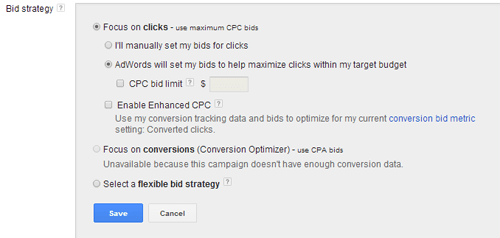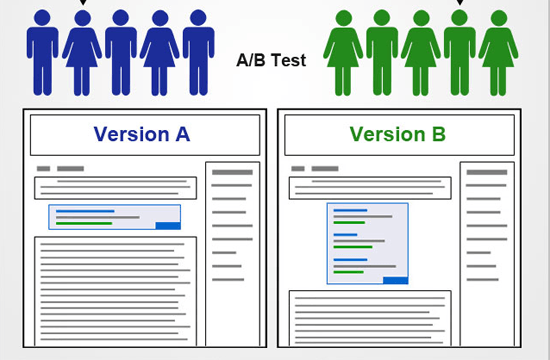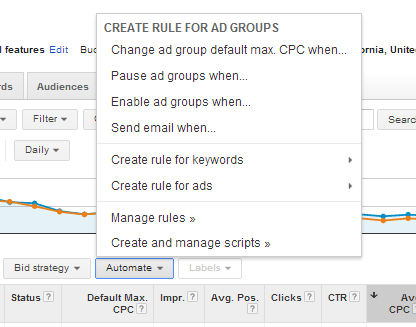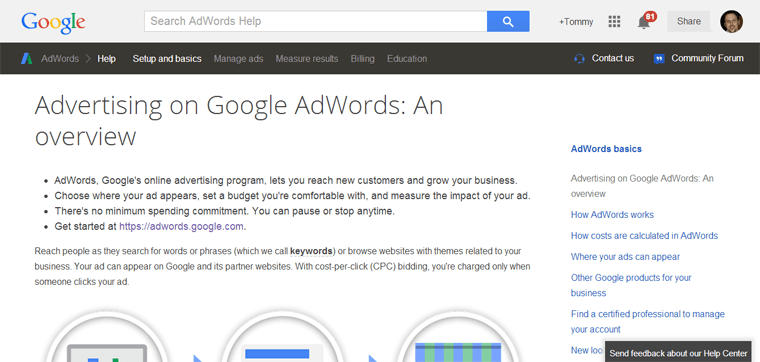As a search marketer by trade, I spend a large percentage of my time working on search engine optimization and search engine marketing on behalf of clients. Naturally, my team’s focus is mostly directed toward Google, at least in the early stages of optimization.
Most of the clients we sign up for SEM, in particular, are running Google AdWords campaigns that are failing to provide much value. Our new clients run the gamut from merely frustrated to ready to cut their losses and stop advertising altogether.
We often see common trends among these accounts. This is why we normally opt to completely rebuild the campaign from the ground up. This is especially true if they have used a provider who was careless or inexperienced with setting up the account in the first place.
This is not a formulaic solution – i.e. my SEM team doesn’t rebuild every single account or campaign using a predetermined methodology. Instead, we look at the dynamics of the business and the industry, figure out how much control we can have over the landing experience, and get creative about what fixes we might apply for this individual account.
The beauty of this approach is we can pick and choose the tactics we apply based on situation. This article will cover some of the more common tactics we consider during our rebuild process. Hopefully it will initiate some creative new ideas for you in improving your own PPC campaigns if you manage it internally.
If you look to hire an outside consultant or agency, this can also serve as a reference list for you to better understand what they are proposing during a similar exercise. Either way, I hope you come away from this piece with some new ideas to go out and test for yourself.
Let’s look at 10 things you might do to breathe new life into your own PPC advertising program:
Re-evaluate the Keyword Targeting Strategy
PPC may look simple at first glance, but there is both an art and a science behind the way you select and target keywords. Let’s cover off some of the basics.
First, be sure you are targeting keywords that are very relevant to your offering. For example, if you sell software that cleans up virtual machine orphan sessions, you wouldn’t target the keyword “virtualization.” That’s not what you are selling. Opt for a more long-tail keyword that better hones in on what you do.
Second, look at potential target keywords with the buyer’s journey in mind. When you see “What is…” types of keywords, those are better suited to SEO since they are information in nature. If you want to drive leads or sell something, you want late funnel keywords in your campaign.
Third, take time to decide which match types are the most important to run. You can employ bid stacking if you like, where you target all of the match types with different bids in the same ad groups. If you are unfamiliar with keyword match types, read this before trying to rework your keywords on your own, or bring in a professional who already gets it.
Restructure Ad Groups Using Tighter Themes
One of the biggest problems we find with existing AdWords campaigns is structural. Badly structured campaigns are very hard to optimize and tend to have a fragmented user experience.
User experience is of massive importance to Google AdWords success. Google assigns a Quality Score to each and every keyword, which is a benchmark of how good the user experience is for that keyword. Quality Scores go from 1-10, and they not only impact how often your ad will show, but also how much you have to pay for a click. You want higher quality scores whenever possible.
When I see ad groups with a bunch of loosely related keywords all set to broad match, I know it was built by someone without much experience in PPC. The key is to build each ad group around very tight themes.
In other words, you want keywords with common verbiage / characters in the same ad group. This allows you to then have all or most of the keywords show up in the ad text, where it will be bolded on the SERP. This has been proven to increase click thrus, which in turn helps bolster quality scores (CTR is one of the major factors in quality score).
Back in early 2013, my company rebuilt an enormous campaign on behalf of one of our larger clients in this manner. It was a smashing success, as the average QS across their account jumped from 5.5 to 8.4 in a matter of two weeks.
Amp Up Your Negative Keywords To Avoid Bad Clicks
If you opt to use a mix of keyword match types, you will find bad clicks are inevitable. For example, say you were targeting “cloud it services” using broad or phrase match. Having tested this keyword, you might find your ads showing up for “serta pillow top mattress” or “cloud music player.”
This is where you would want to deploy negative match keywords. Think of negative match keywords as the “everything but” modifier – i.e. show my ad for all of my keywords targeted, but omit anything with this negative match keyword in it. For the examples above, you might use negative keywords such as “serta,” “mattress,” and “music.”
Note that negative keywords can also be set to broad, phrase, or exact match, so you can widen or narrow the net as needed. You want to be careful how you use them, though, or you could end up filtering out good clicks in addition to bad clicks.
Get More Aggressive With Budget and/or Max Bids
Particularly during the downturn a few years ago, budgets for marketing organizations were squeezed to a minimum. Obsession with ROI was at an all-time high, as companies were struggling to hold on until brighter days arrived.
As budgets were cut, marketing and lead gen teams were forced to operate with one hand tied behind their collective backs. This led to underfunded campaigns, and often, very conservative bidding strategies within those campaigns. These campaigns in turn failed to deliver results.
One thing to keep in mind about PPC – if you plan to get in the game, play it with fervor. Budget as much as you can and bid to win the click.
My team has seen countless campaigns where the marketing team thought a low-budget meant they had to bid a lot lower on the same keywords. As they learned, this leads to low CTR and shrinking quality scores, and little-to-no conversion volume.
It’s okay if your budget is small. Go ahead and bid aggressively, win the click, and do your best to convert them. If you start showing results, it will be much easier to pitch for more budget to support the campaign.
Or even better, do the math to figure out how much average margin you can expect from each and every conversion. Then back that number out to figure out what your investment should be, and start testing with a larger budget behind you.
Bottom line – if you want to succeed at PPC, commit to it. I’ve yet to see an industry or niche where it cannot work, if you are willing to put in the effort to make it happen.
Step Up Your Ad Text Testing Approach
Ad text has a direct impact on click thru rate. I already mentioned how important it is to get the keyword into the ad text when possible. It is also important for ad text to communicate what you are offering and why you are credible.
Even more importantly, ad text should tell the user why to click your ad instead of several dozen other options on the page. Consider you are battling for a click against all of the following:
- Organic Listings
- The Local 7-pack (when present) or Carousel
- The Knowledge Graph or Answer Box (when present)
- Sponsored Results at the Top of the SERP
- Seven Other Sidebar PPC Ads
- Google Navigation Options Such as Images, News, Shopping, Videos, etc.
- Page Two of the SERP
- Google Shopping Listings (when present)
- The Urge to Search For Something Else Using the Search Bar
That’s right, there are nine other potential distractions that may get in the way of winning a click with your ad text. What are you doing to convince readers to click your ad?
This is why ongoing testing of ad text should continue in perpetuity. We always have a minimum of two ads live for every ad group, sometimes up to five for higher volume topics.
AdWords will automatically pick winners, so let it run until you have enough data to draw reasonable conclusions. Once you have a winner, pause the loser(s), deploy some challenger ads, and test again. Lather, rinse, and repeat.
Consider Deploying a Bid Automation Solution
While I mentioned previously that you may want to get more aggressive with your bidding strategy, you would do even better to implement some sort of bid automation (a.k.a. bid management) solution on your account.
These platforms typically automate bids to pursue some pre-determine metric. Typical metrics may be maximizing clicks within budget or hitting a target Return On Ad Spend (ROAS) based on conversion volume and value.
Google offers a simple bid automation feature right within AdWords. If you are low on budget and want to try it out, this is a decent option. The only downside is their automation tends to change max bid across a whole ad group all at one time. You can configure this feature from the settings tab, using the options shown in the image below:
 Screenshot of Bid Automation Settings from Google AdWords UI.
Screenshot of Bid Automation Settings from Google AdWords UI.There are also very good third-party bid platforms that you can choose. The best of these platforms can automate bidding on a keyword level, which allows you to pursue the desired metrics with higher precision. Of course, bid automation platforms come with an added cost, but I’ve found they can deliver against ROAS or ROI goals with a high level of success.
Build a Custom Landing Page for Each Ad Group
When setting quality scores for your keywords, Google reviews the entire user experience from keyword to ad group structure, through to ad text and landing page. Particularly when setting the initial quality score, Google places a lot of emphasis on the quality, usability, design, load time, and presence of related keywords on the landing page.
If you want to maximize the odds of getting a good quality score out of the gate, I highly recommend you create a custom landing page for each of your tightly themed ad groups.
This doesn’t mean you need to recreate the wheel each time. A lot of companies decide to create a single template and swap out the CTA, headline, images (and image ALT-text), and parts of the body copy. But each landing page should be customized to be as relevant as possible for the ad group targeting the page.
A/B Test Landing Pages to Improve Conversion Rate
One thing about PPC – the search engines get paid when the click happens. Google’s biggest concern is the user lands on a relevant page. Once the visit is on your site, conversion is up to you.
If you are seeing good CTR numbers at reasonable CPCs, but also seeing low or no conversions, you need to work on improving the landing page. The most common way to handle this situation is to A/B test landing pages similar to how I recommended you test ad texts.
 A/B Testing Image credit: wikimedia.org. Used under creative commons attribution license.
A/B Testing Image credit: wikimedia.org. Used under creative commons attribution license.There are many guides and tools out there to help you with testing landing pages. You might want to hire a landing page optimization company like Optimizely, Unbounce, or Ion Interactive, or read more about A/B testing online from companies like Hubspot.
Try Out Dynamic Search Ads
Back in 2011, Google announced a beta of their Dynamic Search Ads feature. The idea behind this ad type is that you can use a URL to target content rather than keywords. This feature is now fully up and running and available to any advertiser on the AdWords platform.
To use this sort of campaign, you create a new search network only campaign and configure it to be a Dynamic Search Ad type in the settings. After you submit your domain, Google will offer you ways to target based on the content on the site, categories they assign based on the content, or one of several other targeting options.
You only have to write the two description lines in the ad text. Google will auto-generate the display URL and the headline based on the query that matches your ad and content.
Although there are potential pitfalls to using this ad type, there are also numerous success stories. If you are struggling to make keyword-targeted PPC work, and don’t have the time or bandwidth to learn how to do it right, this may be the answer for you.
Automate Schedules and Budgets to Improve ROI
Google offers the ability to automate several different things within their PPC campaigns. Some of the automation requires scripts, but the simpler functions can be deployed by anyone using the standard AdWords User Interface.
Scheduling is the easiest thing to manipulate, as it is easy to find and change within the campaign settings. Depending on the nature of your business, you may want to only run on select days of the week or hours of the day. I highly recommend you figure out when your customers are most likely to be online and ready to convert. Then run the ads when you are most likely to see results.
Another option that you can use to your advantage is to automate the budget or bids. You can set this to adjust on a daily or hourly basis.
Below is where you can find the “Automate” button from the campaign view. As you can see, there are options to automate pausing/enabling ad groups, changing bids on keywords, and more.
 Screenshot taken from Google Adwords Interface.
Screenshot taken from Google Adwords Interface.If there is some sort of automation you want to try that is not showing in this view, you can click on “Manage Rules” to create custom automation using the UI, or “Create and manage scripts” if you want to build more in-depth automation functions using Javascript.
Summary
If you are struggling to derive value from your Google AdWords campaigns, all hope is not lost. There are proven tactics you can roll out to improve your odds of success. Hopefully, these ten ideas spark some creative ideas in your own mind. If you want to push the envelope faster, I highly recommend you bring in an SEM agency or consultant who can evaluate your options and help you get there faster.
What other common changes have you seen that most people overlook? Any good case studies you’ve witnessed firsthand where these tactics paid off in a major way?





